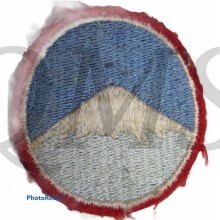Mouwembleem US Far East Command
Far East Command (United States) was a United States military command from 1947 until 1957 comprising United States Army Forces in the Far East, Far East Air Forces and Naval Forces Far East.
Created January 1, 1947, abolished, with functions transferred to Pacific Command, effective July 1, 1957, pursuant to JCS 1259/378. Major army commands under the FEC were the Eighth United States Army, the Ryukyus Command, and the Marianas-Bonin Command (MARBO). MARBO was established under MacArthur's Far East Command in January 1947 as result a major reorganization of U.S. military forces in the Asia/Pacific region. The MARBO SSI was approved in August 8, 1948.
In June 1950 GHQ, FEC, located in Tokyo, Japan, with main offices in the Dai Ichi Building, had Maj. Gen. Edward M. Almond as chief of staff and Maj. Gen. Doyle O. Hickey as deputy chief of staff. The major subordinate Army commands were Eighth Army, commanded by Lt. Gen. Walton H. Walker; Headquarters and Service Group, GHQ, commanded by Maj. Gen. Walter L. Weible; the Ryukyus Command (RYCOM) under Maj. Gen. Josef R. Sheetz; and the Marianas-Bonins Command (MARBO) headed by Maj. Gen. Robert S. Beightler. In the Philippines, the Thirteenth Air Force controlled U.S. installations through PHILCOM (AF), a small and rapidly diminishing headquarters commanded by Maj. Gen. Howard M. Turner, USAF Naval Forces, Far East, were commanded by Vice Adm. C. Turner Joy. Far East Air Forces came under Lt. Gen. George E. Stratemeyer. FEAF and NavFE headquarters were located in Tokyo in buildings separate from GHQ, FEC. The PHILRYCOM marriage of convenience did not last out 1948, as the union was separated into a Philippine Command (PHILCOM) and a Ryukyus Command (RYCOM) on August 1, 1948 (SCAP, GHQ General Order Number 18, July 9, 1948). XVI Corps was activated in April 1951 as the command reserve.
Following signing of the Japanese Instrument of Surrender, September 2, 1945, Ryukyu Islands were administered by Department of the Navy, September 21, 1945 - June 30, 1946, with Commanding Officer, Naval Operating Base, Okinawa functioning as chief military government officer under authority of Commander-in-Chief U.S. Pacific Fleet. Transfer of administration from Department of the Navy to War Department authorized by Joint Chiefs of Staff (JCS) approval, April 1, 1946, of JCS 819/11, March 5, 1946, with added proviso of JCS 819/12, March 22, 1946. Pursuant to implementing instructions of General Headquarters U.S. Army Forces in the Pacific (GHQ AFPAC), Okinawa Base Command redesignated Ryukyus Command, effective July 1, 1946, by General Order 162, Headquarters U.S. Army Forces, Western Pacific, and made responsible for administration under a Deputy Commander for Military Government. Ryukyu Islands administered successively by Ryukyus Command, July 1-November 30, 1946; Philippines-Ryukyus Command, December 1, 1946-July 31, 1948; and Ryukyuan Command, August 1, 1948-December 15, 1950. USCAR established, effective December 15, 1950, by a directive of Headquarters Far East Command (HQ FEC, formerly GHQ AFPAC), AG 091.1 (5 Dec 50) RCA, December 5, 1950, implementing a JCS memorandum, SM 2474-50, October 11, 1950, directing Commander-in-Chief Far East, Gen. Douglas MacArthur, to organize a civil administration for the Ryukyu Islands in accordance with JCS 1231/14, October 4, 1950. USCAR continued to function under Department of the Army (formerly War Department), 1950-71.



